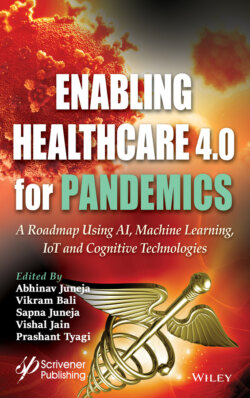Читать книгу Enabling Healthcare 4.0 for Pandemics - Группа авторов - Страница 45
2.4 Opportunities and Limitations
ОглавлениеHCS 4.0 techniques would offer innovative digital interventions during everyday living in the crisis [38]. For example, evaluating risk worldwide, planning public health emergency actions against COVID-19, producing the protective equipment and delivering timely medical supplies via the intelligent supply chain, using robots in caring for infected patients and reducing the risk of exposure to infection among healthcare providers, training staff using virtual reality, supporting more adaptable healthcare setting, performing everyday living activities in the lockdown, and detecting misinformation in the different media channels [6].
The speed and scale of the COVID-19 pandemic is more or less ahead of the health systems of all countries. Diagnosing, maintaining, treating, and tracking people with suspected infections has become physically difficult because existing healthcare systems based on a historically necessary model of interaction between patients and their physicians have facilitated viral transmission. Globally, several governments have realized the need of an immediate digital revolution to counter this. Therefore, countries around the world have had to take steps to transform healthcare and expand it through the power of digital technology. Unfortunately, even in the developed world, where telemedicine has existed for decades, it has had a weak penetration of the services market, due to rigid, unresolved regulatory mechanisms. With the advent of the pandemic of COVID-19, several countries, including the US, repealed all provisions restricting remote and telemedicine services and began to actively implement it in healthcare.
In turn, prolonged and improper use of various trackers and mobile applications for smartphones can cause users side effects such as neck pain, elbows, upper back, shoulder girdle, and numbness in both fingers and hands. It is worth noting that long-term use of smartphones contributes to the development of a specific syndrome of “Text neck”, which is accompanied by pain and curvature in the cervical spine. In addition, long-term use of smartphones and tablets contributes to the appearance of such unpleasant phenomena as: “smartphone”, “selfie-wrist”, “self-elbow”, “computer hump”. “Click finger”, “Cell phone-elbow”.
The development of tools for prevention, early diagnosis and forecasting based on the use of DL and ML with the involvement of IoT technologies and AI requires a huge amount of quality data. The key word—Quality! In order for these technologies to be able to generate qualitative conclusions, they must learn from qualitative and sufficient examples. After all, bad results would be obtained while training models on non-representative data. Unfortunately, data sets of medical images and textual analysis are limited in comparison to the needs of in-depth training. Many of them are not digitized in real time, or contain errors. The key cause of the shortage of collected data is their usual incompatibility in different geographical regions, poor accessibility of the population to medical facilities in developing countries.
